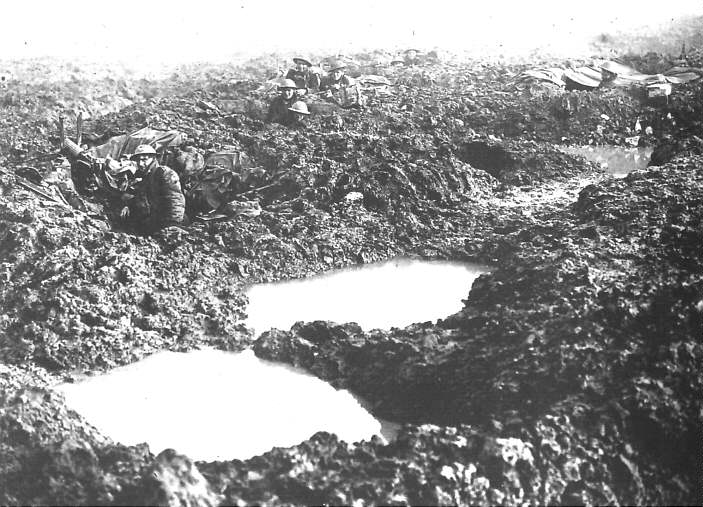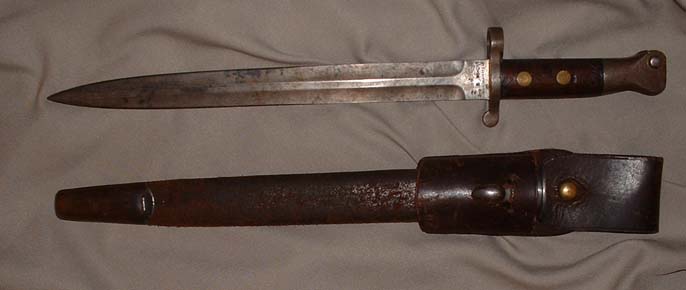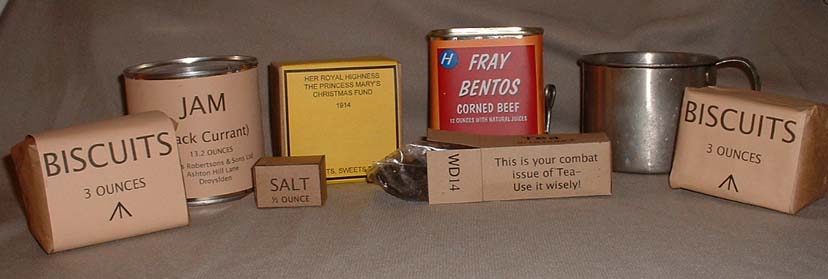|

|
| credit: http://www.ku.edu/~kansite/ww_one/photos/ |
Since the colonial wars in Africa and elsewhere of the 1870's and 1880's, where many actions were fought by smaller units
not generally equipped with a mess section, British military planners, troop commanders and explorers began to recommend portable
rations. These were to be different from the standard fare of loose issues of food items that would spoil or be pilfered by
animals, such as fresh meat, flour, vegetables or dairy products. Initially, a "secure ration" was designed consisting of
nothing more than ½ pound (225gr) of "Good quality Naval Biscuit" and a half-ounce of salt. This was placed in a waxed paper
wrapper, but proved quite unsuitable and insufficient to theater commanders and troops alike.
During the early 1880's, with the support of popular explorers such as Burton and Stanley, the British Army began casting
about for a more portable "standard" ration, which could be counted on to sustain troops on campaign when cut off from regular
sources of supply.
The first such product obtained was through the Bovril Company of London. It consisted of a metal or waxed fiberboard tube,
which was partitioned in the middle. The metal versions of these generally had a soldered-on cap in place at both ends which
was removed via a peel-away metal strip (similar to turn-key ham tins). The fiber board or waxed cardboard versions had glued-in-place
caps with a piece of canvas tape protruding to facilitate opening.
One end held 'Bovril Paste', also known as 'Johnston's Fluid Beef', or what is known today as instant bullion (the pasty
stuff mum uses to make kidney soup with). This portion of the container was normally marked 'Dinner'.
The other end held either a temperature resistant chocolate bar or cocoa powder. The portion of the container holding the
chocolate was either marked 'Chocolate Ration', or 'Cocoa', regardless whether actual chocolate or cocoa powder was inside.
There were a variety of these rations produced clear into the early part of the 20th century, and many Bovril
emergency rations made for the Boer war found their way into Royal navy emergency supplies during World War I, nearly 20 years
after they had been made!
It is unclear whether the quality was high enough to warrant this, or if British thriftiness had gotten the better of the
bluejacket's planners...
This was supplemented by one or more packs of biscuit. The emergency ration was meant to only be consumed when no other
rations were available, and became a standard item carried by all soldiers of the empire in one form or another. Even though
a standard issue was made, slightly better versions were offered for purchase by individual soldiers. These included tinned
dry beef, biscuits and tea, tubes with a compartment for tobacco, and even some that combined all features in a tapered tin
similar to the ones used to can fish, which was manufactured in Canada and prized above others. When these metallic tapered
tins were purchased, a clasp knife with built-in tin opener was generally sold right along with them, which became a standard
gift of commander's to troops, and eventually led to the general issue of such knives.
During the Boer war, many new innovations came into play, including rapid-fire
volleys from repeating rifles, machineguns, general issue of camouflage clothing, (albeit limited) motorized transport, and
a greater availability of tinned goods.
Even though the Commissariat and Transport Department did supply a certain
amount of tinned goods to the unit, much was either obtained via private purchase or, in the case of volunteer units, at the
expense of the unit commander. Generally, tin cans were of a commercial quality, and sported labels as would be found in stores.
There was a great variety of tinned goods available, but on campaign, the following would normally encountered in the packs
of troops:
1. Tinned meats, fowl and fish (both issue and private purchase varieties)--Corned
Beef, Pork Loaf, Liver Paste, Sardines (in Cylindrical tins rather than the current flat ones), Chicken Meats and Turkey Bits.
2. Tinned Milk. Both the evaporated and the sweetened condensed varieties were
in use, and were greatly prized by a nation of tea drinkers. The most common size was the 12 ounce tin, and many a Pattern
88 bayonet still bears nicks near the tip from frequent use as a milk tin opener!
3. Tinned 'Hash' and other ready-to-eat items such as the various stews were also
encountered quite frequently, with sizes ranging from 12 ounce tins right up to 48 ounce tins.
4. Tinned Beans (in a variety of sauces) were also quite frequently encountered.
When touring Boer War battle fields today, you know that you have found the
general vicinity when you come across large quantities of ancient seeming tin cans, flattened by time and by the soldiers
themselves!
As an aside...
During the Boer war, British soldiers were issued with coffee and coffee grinders,
as coffee was considered an important part of the evening meal! Of course, the troops were very likely to promptly use the
coffee mills to grind mealie meal (African Cornmeal, which was issued rather coarsely ground as part of the portable ration)
into cereal for stewing, rather than using them for their intended purpose.

Equipped with the knowledge from lessons learned during the Boer War and the Boxer Rebellion, British military planners
realized the shortcomings of the emergency ration, and began planning for a more substantial standard 'Iron' ration troops
could subsist on for days at a time. Even though the Bovril packs had been popular on campaign, the essentially liquid diet
they provided had been found wanting by troops and commanders alike.
During the Boxer Rebellion troops mocked this ration when dead Boxers were unceremoniously transported on carts that had
brought rations during the rebellion, by changing the cargo marker signs on the carts from 'Bovril' to 'Boxvril', as the dead
Boxers were "as packed and as unappetizing as the rations what rode the carts before 'em..."
By 1903, changes appeared not only in the equipment of the British soldier, with the introduction of the so-called "Pattern
03" web gear that allowed for lower care pan-climatic use, but also in the supply system for these soldiers. Where previously
a soldier was thought well to be equipped with 100 cartridges, campaigns against fanatical enemies in remote areas help
revise that estimate. The Pattern '03 not only provided for 100 rounds of .303 ball ammunition in pouches on the webbing,
but also for the standard carry of two additional bandoleers of 50 rounds each on campaign, which was at times bumped up to
4 bandoleers. To feed the soldier through the protracted engagements envisioned, the iron ration was expanded to include:
Preserved Meat (1 Tin). These were initially designed to be 1lb tins, but were soon replaced by 14-ounce tins of such
'greats' as pork loaf and tinned corned beef (aka 'Bully Beef).;
Biscuit (12 ounces). This normally was issued in either two 6-ounce packs or four 3-ounce packs. Both varieties were
contained in an inner wrapper of waxed paper or the Swiss chemist Jacques Edwin Brandenberger's new invention---Cellophane!
This packet was then wrapped in a paper outer wrapper, bearing a label identifying the contents.
Tea (5/8 ounce) in either a rolled-up envelope with a paper label, or a neat little waxed box.
Sugar (2 ounces) This was issued in small sugar boxes of loose sugar, or blocks of wrapped sugar tablets.
Salt (1/2 ounce) was issued in small boxes which either held the salt directly, or a small cellophane or tin-foil envelope
containing salt
Meat Extract (1 ounce). This initially came in a brown paper wrapper containing two or three flat tablets of bouillon,
but later was issued in a variety of ways, such as the classic "OXO" brand cubes.
In addition, a 3-ounce ration of Cheese would be provided where possible.
This iron ration was reserved for periods where troops were cut off from supply channels. Where such delays in resupply
could be anticipated, and where regular resupply through the mess services could not be guaranteed, the British issued durable
rations which troops could prepare in the trenches. Especially later in the war, it was considered safer to cook in the trenches
than bringing food up from the rear.
Many British soldiers died from enemy action (artillery, plunging machinegun fire, aeroplanes and snipers) not attacking
German lines, but carrying food carriers forward to their own troops. 'Death by Dixie' (the name of the mess-food carriers
and cooking gear in general) became an all too frequent event.
These Daily Rations consisted of :
Preserved meat--(1 pound, which often just turned out to be an additional tin of Bully Beef)
Bread--(1.25lbs, but generally replaced by a lesser quantity of additional biscuits). This was often partially substituted
(and on rare occasions supplemented) with either 4 ounces of oatmeal or rice.
Cheese--(3 ounces, supplied in 6-ounce tins). These often came painted with a drab or khaki protective coating, not
for reasons of camouflage, but because of the potential for metal fouling, as many of these tins came from far-off Australia
and New Zealand.
Bacon--(4 ounces, but often in the form of canned pork or beef) Butter, Lard or cooking oil were sometimes issued in
lieu of.
Tea--(5/8 ounce; either in loose form from a large box or tin, or in the familiar small wax-packs). At times, this
was replaced by 1/3 ounce of chocolate powder in small envelopes.
Salt--(1/2 ounce) was issued either by the pinch from boxes, or by the small individual box.
Jam-(4 ounces). This came in 13.2-ounce tins to be shared out by sections. Contrary to the much repeated "the only
jam was Ticklers Plum and Apple", a variety of 13.2-ounce tins of jam were available, which included marmalade and assorted
berry flavours which, alas, all seemed to taste more of "sugar and colour" than of any fruit. The squat tins were saved and
put to a myriad of uses, from trench art, over cups to more tactical uses, such as alarm systems in the wire and the manufacture
of jam-tin bombs.
Sugar--(3 Ounces) either dished out from boxes or tins/fiber containers, or, fairly late in the war, provided in 3-ounce
boxes.
Vegetables--Either 8 ounces fresh or 2 ounces dried varieties were provided, but often times instead of the regular
meat and vegetable rations, stewed and tinned combinations were provided instead
M&V (generally in 20 to 24 ounce tins) was provided from various manufacturers. This was what today would pass
for Beef or Meat stew, but often was of poor quality and featured chunks of lard floating atop thin soup with low-grade meat
and potatoes or beets. Maconochie Brothers brand was said to be one of the more edible varieties, and both commercially labeled
and plain buff-colour labeled tins are encountered.
Tinned Beans became a standard issue item between 1916 and 1917, when meat supplies were at their lowest.
These were the standard varieties, which normally were eaten either right out of the tin, or used on biscuits or bread as
a topping.
Additionally, there were rations (based on availability) of pepper, tobacco, and mustard.
On special occasions (such as Christmas), troops were issued with gift packages (such as the famous Princess Mary Christmas
Gift of 1914) which contained anything from writing implements, to chocolates and tobacco items.

|
| Some of Tommy's WW1 Rations |
|

